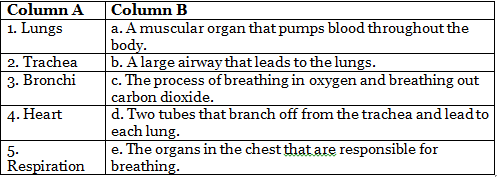Class 7 Exam > Class 7 Notes > Class 7 Oxford Science: Chapter Notes, Worksheets & Tests > Worksheets: Respiration in Organisms
Respiration in Organisms Class 7 Worksheet Science Chapter 6
| Table of contents |

|
| Section A: Multiple Choice Questions |

|
| Section B: Short Questions |

|
| Section C: Fill in the Blanks |

|
| Section D: Match the Column |

|
| Section E: True or False |

|
Section A: Multiple Choice Questions
Q.1. Which of the following is NOT a respiratory organ in animals?
(a) Lungs
(b) Gills
(c) Skin
(d) Heart
Q.2. During aerobic respiration, what is the final waste product?
(a) Carbon dioxide
(b) Water
(c) Lactic acid
(d) Ethanol
Q.3. Which of the following is NOT a function of the respiratory system in humans?
(a) Gas exchange
(b) Regulation of blood pH
(c) Production of red blood cells
(d) Sense of smell
Q.4. In which type of respiration is oxygen not required?
(a) Aerobic respiration
(b) Anaerobic respiration
(c) Photosynthesis
(d) None of the above
Q.5. Which of the following is NOT a respiratory structure in plants?
(a) Stomata
(b) Lenticels
(c) Roots
(d) Leaves
Section B: Short Questions
Q.1. What is respiration?
Q.2. What is the difference between aerobic and anaerobic respiration?
Q.3. How does the respiratory system in humans help regulate blood pH?
Q.4. What is the function of stomata in plants?
Q.5. What is the role of gills in aquatic animals?
Section C: Fill in the Blanks
Q.1. The process of breathing in oxygen and breathing out carbon dioxide is called ________.
Q.2. The respiratory system in humans consists of the ______, ______, _______, _____, and _______.
Q.3. The process of breaking down glucose to release energy in the absence of oxygen is called ______ respiration.
Q.4. The process of breaking down glucose to release energy in the presence of oxygen is called _______ respiration.
Q.5. The respiratory system in plants takes place through tiny openings on the surface called _______.
 |
Download the notes
Worksheets: Respiration in Organisms
|
Download as PDF |
Download as PDF
Section D: Match the Column
Match the terms in Column A with their definitions in Column B.

Section E: True or False
Q.1. The respiratory system in animals is different from the respiratory system in humans.
Q.2. The process of respiration takes place only in animals.
Q.3. Plants also have a respiratory system.
Q.4. Aerobic respiration requires oxygen, while anaerobic respiration does not.
Q.5. The respiratory system in humans consists of the nose, trachea, lungs, and liver.
You can access the solutions to this worksheet here.
The document Respiration in Organisms Class 7 Worksheet Science Chapter 6 is a part of the Class 7 Course Class 7 Oxford Science: Chapter Notes, Worksheets & Tests.
All you need of Class 7 at this link: Class 7
|
140 videos|108 docs|18 tests
|
FAQs on Respiration in Organisms Class 7 Worksheet Science Chapter 6
| 1. What is respiration in organisms? |  |
| 2. What are the different types of respiration? |  |
Ans.The two main types of respiration are aerobic respiration and anaerobic respiration. Aerobic respiration requires oxygen and produces more energy, while anaerobic respiration occurs in the absence of oxygen and produces less energy.
| 3. How does respiration differ in plants and animals? |  |
Ans.In plants, respiration occurs both during the day and night, as they take in oxygen and release carbon dioxide. In contrast, animals primarily respire during the day and night, taking in oxygen from the environment for metabolic processes.
| 4. What is the role of the respiratory system in humans? |  |
Ans.The respiratory system in humans is responsible for the exchange of gases. It allows oxygen to enter the body through the lungs and facilitates the removal of carbon dioxide, which is a waste product of respiration.
| 5. Why is respiration important for living organisms? |  |
Ans.Respiration is crucial for living organisms as it provides the energy needed for various biological processes, including growth, reproduction, and maintaining homeostasis. Without respiration, cells would not be able to function effectively.
|
140 videos|108 docs|18 tests
|
Download as PDF
Top Courses for Class 7
Related Searches



















